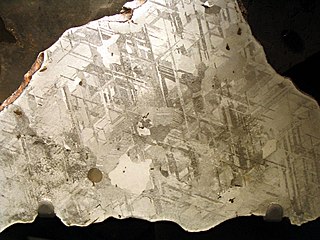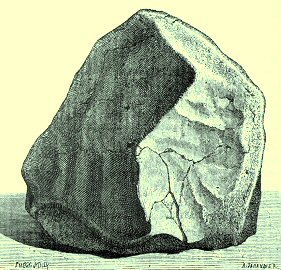| Hexamolybdenum | |
|---|---|
| General | |
| Category | Native mineral alloy |
| Formula (repeating unit) | (Mo,Ru,Fe,Ir,Os) |
| IMA symbol | Hmo [1] |
| Strunz classification | 1.XX.00 |
| Crystal system | Hexagonal |
| Crystal class | Dihexagonal dipyramidal (6/mmm) H-M symbol: (6/m 2/m 2/m) |
| Space group | P63/mmc |
| Unit cell | a = 2.7506, c = 4.4318 [Å] V = 29.04 Å3, Z = 2 |
| Identification | |
| Crystal habit | Inclusions and microscopic crystals |
| Specific gravity | 11.90 (calculated) |
| References | [2] [3] [4] |
Hexamolybdenum is a molybdenum dominant alloy discovered during a nanomineralogy investigation of the Allende meteorite. [4] Hexamolybdenum was discovered in a small ultrarefractory inclusion within the Allende meteorite. [4] This inclusion has been named ACM-1. [4] Hexamolybdenum is hexagonal, with a calculated density of 11.90 g/cm3. [4] The new mineral was found along with allendeite. [4] These minerals, are believed to demonstrate conditions during the early stages of the Solar System, as is the case with many CV3 carbonaceous chondrites such as the Allende meteorite. [4] Hexamolybdenum lies on a continuum of high-temperature alloys that are found in meteorites and allows a link between osmium, ruthenium, and iron rich meteoritic alloys. [4] The name hexamolybdenum refers to the crystal symmetry (primitive hexagonal) and the molybdenum rich composition. [4] The Allende meteorite fell in 1969 near Pueblito de Allende, Chihuahua, Mexico. [4]
Hexamolybdenum was found as nano-crystals in an ultrarefractory inclusion in the Allende meteorite. [4] The Allende meteorite has shown to be full of new minerals, after nearly forty years it has produced one in ten of the now known minerals in meteorites. [4] This CV3 carbonaceous chondrite was the largest ever recovered on earth and is referred to as the best-studied meteorite in history. [4] The inclusion has only been viewed via electron microscopy. [4] The hexamolybdenum specimen was lost during an attempted ion probe analysis of a bordering grain. [4] Other specimens can be found, however, in the Smithsonian Institution's National Museum of Natural History Allende section USNM 3509HC12 and in section USNM 7590 of NWA 1934, another VC3 chondrite. [4]
It has also been reported from the NWA 1934 CV3 carbonaceous chondrite meteorite from the Erfoud region of Morocco and in the Danubian placer of Straubing, Bavaria. [2]
Hexamolybdenum is an (molybdenum, ruthenium, iron, iridium, osmium) alloy. [4]
Color, streak, luster, hardness, tenacity, cleavage, fracture, density, and refractive index could not be observed because the grain size was too small and the section bearing the mineral was optically thick. [4]

Kamacite is an alloy of iron and nickel, which is found on Earth only in meteorites. According to the International Mineralogical Association (IMA) it is considered a proper nickel-rich variety of the mineral native iron. The proportion iron:nickel is between 90%:10% and 95%:5%; small quantities of other elements, such as cobalt or carbon may also be present. The mineral has a metallic luster, is gray and has no clear cleavage although its crystal structure is isometric-hexoctahedral. Its density is about 8 g/cm3 and its hardness is 4 on the Mohs scale. It is also sometimes called balkeneisen.

A chondrule is a round grain found in a chondrite. Chondrules form as molten or partially molten droplets in space before being accreted to their parent asteroids. Because chondrites represent one of the oldest solid materials within the Solar System and are believed to be the building blocks of the planetary system, it follows that an understanding of the formation of chondrules is important to understand the initial development of the planetary system.

A chondrite is a stony (non-metallic) meteorite that has not been modified, by either melting or differentiation of the parent body. They are formed when various types of dust and small grains in the early Solar System accreted to form primitive asteroids. Some such bodies that are captured in the planet's gravity well become the most common type of meteorite by arriving on a trajectory toward the planet's surface. Estimates for their contribution to the total meteorite population vary between 85.7% and 86.2%.

Orgueil is a scientifically important carbonaceous chondrite meteorite that fell in southwestern France in 1864.

Carbonaceous chondrites or C chondrites are a class of chondritic meteorites comprising at least 8 known groups and many ungrouped meteorites. They include some of the most primitive known meteorites. The C chondrites represent only a small proportion (4.6%) of meteorite falls.

Hedenbergite, CaFeSi2O6, is the iron rich end member of the pyroxene group having a monoclinic crystal system. The mineral is extremely rarely found as a pure substance, and usually has to be synthesized in a lab. It was named in 1819 after M.A. Ludwig Hedenberg, who was the first to define hedenbergite as a mineral. Contact metamorphic rocks high in iron are the primary geologic setting for hedenbergite. This mineral is unique because it can be found in chondrites and skarns (calc–silicate metamorphic rocks). Since it is a member of the pyroxene family, there is a great deal of interest in its importance to general geologic processes.

Osmiridium and iridosmine are natural alloys of the elements osmium and iridium, with traces of other platinum-group metals.

A native metal is any metal that is found pure in its metallic form in nature. Metals that can be found as native deposits singly or in alloys include aluminium, antimony, arsenic, bismuth, cadmium, chromium, cobalt, indium, iron, manganese, molybdenum, nickel, niobium, rhenium, selenium, tantalum, tellurium, tin, titanium, tungsten, vanadium, and zinc, as well as the gold group and the platinum group. Among the alloys found in native state have been brass, bronze, pewter, German silver, osmiridium, electrum, white gold, silver-mercury amalgam, and gold-mercury amalgam.

The Allende meteorite is the largest carbonaceous chondrite ever found on Earth. The fireball was witnessed at 01:05 on February 8, 1969, falling over the Mexican state of Chihuahua. After it broke up in the atmosphere, an extensive search for pieces was conducted and over 2 tonnes were recovered. The availability of large quantities of samples of the scientifically important chondrite class has enabled numerous investigations by many scientists; it is often described as "the best-studied meteorite in history." The Allende meteorite has abundant, large calcium–aluminium-rich inclusions (CAI), which are among the oldest objects formed in the Solar System.
Alan Stanley Kornacki is an American geologist and retired Army colonel, currently the Senior Staff Geochemist at Shell International Exploration and Production Inc. He received a B.S. in geology from the University of Missouri–Rolla in 1974 before completing his M.S. and Ph.D. in geology at Harvard University in 1984 on a Graduate Research Fellowship. His dissertation focused on refractory inclusions in carbonaceous chondrites. He began a career in the petroleum industry in 1985 when he joined Shell USA. In 1981, he was awarded the Nininger Meteorite Award, and in 2008, he was awarded a professional degree by the University of Missouri–Rolla. Alan Kornacki is most known for his characterization of wax from deep-water crude oil, an important obstacle in modern drilling and refining technology, and his research on new sources of hydrocarbons such as oil shale.

Enstatite chondrites are a rare form of meteorite, rich in the mineral enstatite. Only about 200 E-Type chondrites are currently known, comprising about 2% of the chondrites that fall on Earth. There are two main subtypes: EH and EL, classified based on their iron content.

Khatyrkite is a rare mineral which is mostly composed of copper and aluminium, but may contain up to about 15% of zinc or iron. Its chemical structure is described by an approximate formula (Cu,Zn)Al2 or (Cu,Fe)Al2. It was discovered in 1985 in a placer in association with another rare mineral cupalite. These two minerals have only been found at 62°39′11″N174°30′02″E in the area of the Iomrautvaam, a tributary of the Khatyrka river, in the Koryak Mountains, in Anadyrsky District, Chukotka, Russia. Analysis of one of the samples containing khatyrkite showed that the small rock was from a meteorite. A geological expedition has identified the exact place of the original discovery and found more specimens of the Khatyrka meteorite. The mineral's name derives from the Khatyrka zone where it was discovered. Its type specimen is preserved in the Mining Museum in Saint Petersburg, and parts of it can be found in other museums, such as Museo di Storia Naturale di Firenze.
CI chondrites, also called C1 chondrites or Ivuna-type carbonaceous chondrites, are a group of rare carbonaceous chondrite, a type of stony meteorite. They are named after the Ivuna meteorite, the type specimen. CI chondrites have been recovered in France, Canada, India, and Tanzania. Their overall chemical composition closely resembles the elemental composition of the Sun, more so than any other type of meteorite.
Krotite is a natural mineral composed of calcium, aluminium and oxygen, with the molecular formula CaAl2O4. It is the low-pressure dimorph of CaAl2O4, of which the high-pressure dimorph is named dmitryivanovite.

Icosahedrite is the first known naturally occurring quasicrystal phase. It has the composition Al63Cu24Fe13 and is a mineral approved by the International Mineralogical Association in 2010. Its discovery followed a 10-year-long systematic search by an international team of scientists led by Luca Bindi and Paul J. Steinhardt to find the first natural quasicrystal.
This is a glossary of terms used in meteoritics, the science of meteorites.
Allendeite, Sc4Zr3O12, is an oxide mineral. Allendeite was discovered in a small ultrarefractory inclusion within the Allende meteorite. This inclusion has been named ACM-1. It is one of several scandium rich minerals that have been found in meteorites. Allendeite is trigonal, with a calculated density of 4.84 g/cm3. The new mineral was found along with hexamolybdenum. These minerals, are believed to demonstrate conditions during the early stages of the Solar System, as is the case with many CV3 carbonaceous chondrites such as the Allende meteorite. It is named after the Allende meteorite that fell in 1969 near Pueblito de Allende, Chihuahua, Mexico.
The geochemistry of carbon is the study of the transformations involving the element carbon within the systems of the Earth. To a large extent this study is organic geochemistry, but it also includes the very important carbon dioxide. Carbon is transformed by life, and moves between the major phases of the Earth, including the water bodies, atmosphere, and the rocky parts. Carbon is important in the formation of organic mineral deposits, such as coal, petroleum or natural gas. Most carbon is cycled through the atmosphere into living organisms and then respirated back into the atmosphere. However an important part of the carbon cycle involves the trapping of living matter into sediments. The carbon then becomes part of a sedimentary rock when lithification happens. Human technology or natural processes such as weathering, or underground life or water can return the carbon from sedimentary rocks to the atmosphere. From that point it can be transformed in the rock cycle into metamorphic rocks, or melted into igneous rocks. Carbon can return to the surface of the Earth by volcanoes or via uplift in tectonic processes. Carbon is returned to the atmosphere via volcanic gases. Carbon undergoes transformation in the mantle under pressure to diamond and other minerals, and also exists in the Earth's outer core in solution with iron, and may also be present in the inner core.
CM chondrites are a group of chondritic meteorites which resemble their type specimen, the Mighei meteorite. The CM is the most commonly recovered group of the 'carbonaceous chondrite' class of meteorites, though all are rarer in collections than ordinary chondrites.

The Kaba meteorite, a 2,601 kilogram stone, struck the outskirts of the Hungarian town of Kaba on 15 April 1857 at around 10 pm. The roughly loaf-shaped meteorite has a maximum diameter of 16.4 centimeters, a minimum diameter of 10 centimeters and a height of 10.8 centimeters. Its mass on the ground must have been about 4 kilograms. Its official name as recorded in the Meteoritical Bulletin is Kaba.